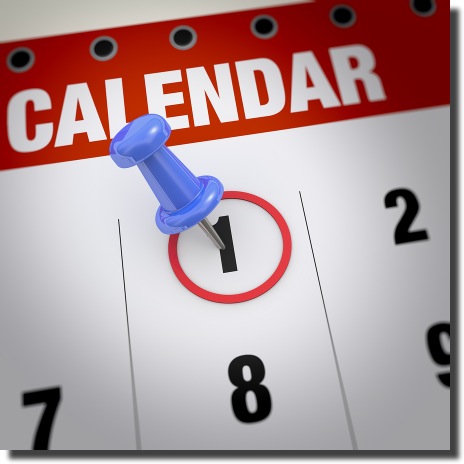 In the last article, we looked at using a monthly guitar practice log to help make your practice more consistent. In this article we’ll be looking at the yearly guitar practice log, which is another useful tool that can be used to speed up your progress.
In the last article, we looked at using a monthly guitar practice log to help make your practice more consistent. In this article we’ll be looking at the yearly guitar practice log, which is another useful tool that can be used to speed up your progress.
Before we go any further, it would be a great idea to download and print out the log. You can do this by clicking on the blue button below…
Download Yearly Guitar Practice Log
Now that you’ve got the practice log in front of you, let’s now look at the various elements of it…
The First Table
If you look at the top left hand part of the practice log, you’ll see this table…
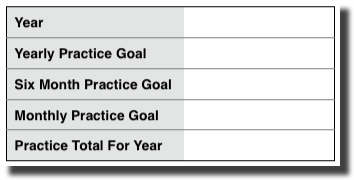
Here’s what each part of the table means…
- Year: Here you’ll write down what year the log is for.
- Yearly Practice Goal: In this row, you’ll write down the total amount of practice (in minutes) that you’re aiming for that year. One way to choose this goal is to think of a realistic daily average amount and multiply that by 365. For Example: If you feel that doing an average of 60-minutes a day practice is realistic, then your yearly practice goal would be 21,900 minutes. (This is 60 x 365). Of course, you should discuss this goal with your guitar teacher—they’ll be able to give you some guidance on how hard you need to work in order to reach your musical goals.
- Six Month Practice Goal: This goal is created by taking your yearly goal, and dividing it by two. For Example: If your yearly goal is 21,900 minutes, then your six month practice goal will be 10,950 minutes. (This is 21,900 ÷ 2).
- Monthly Practice Goal: As you can probably guess, your monthly practice goal is your yearly goal divided by twelve. For Example: If your yearly goal is 21,900 minutes, then your monthly practice goal will be 1,825 minutes. (This is 21,900 ÷ 12). [Side Note: Your monthly practice goal is really helpful, because it gives you a realistic target to aim for with your monthly guitar practice log].
- Practice Total For Year: This row can only be filled out after the year you’re logging has finished, and will be the total amount of guitar practice you did for the entire year.
Have a look below to see an example of one that’s been filled out. Yes—it’s totally made up because, at the time of writing this article, 2015 hasn’t ended yet. But, despite it’s fictional nature, it should give you a pretty good idea of what a completed table might look like.
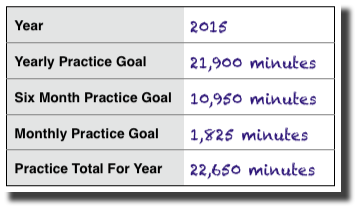
You can see from the table above that this guitarist was extremely diligent with their practice. They manage to exceed their yearly practice goal by 750 minutes—great work, and I hope they buy themselves a new guitar to celebrate! 🙂
The Practice Logging Area
This part of the handout is comprised of two tables, each of which lasts for six months. In these tables you’ll enter how much practice you do for each month of the year.
Here’s what the blank tables look like…
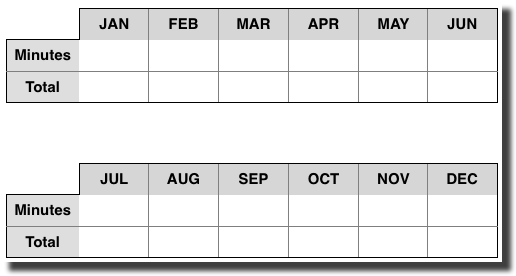
To complete these tables, you’ll need to enter these details…
- Minutes: In this area, you’ll write down how much guitar practice you did for the month that’s just finished. (You’ll get this figure from the monthly guitar practice log, that you filled out for that month).
- Total: This area of the tables is where you keep a running total for the year. This means that each new month’s practice amount is added to the total amount from the previous month.
Let’s see an example of what a completed log might look like…
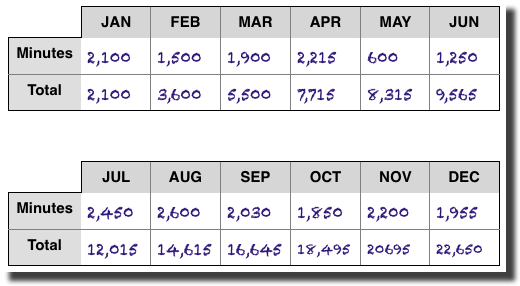
The Goals Section
The final part of the yearly practice log is the goals section. In this section, you’ll write down your musical goals for the year that you’re logging. This is important because it will remind you why you’re actually practicing guitar in the first place. I can’t imagine too many people are heavily motivated by the thought of filling out practice logs, so it’s helpful to have your goals there to give you the necessary motivation, if you’re ever feeling less-than-inspired.
A Few Last Words
If you’re keeping a monthly guitar practice log then it’s definitely a good idea to also keep a yearly log. It will allow you to see at a glance how consistent your practice is using a longer time-frame, and will also give you a monthly practice amount target to work towards. And, because it will only take you a minute or so every month to fill out, it’s hardly going to be a serious imposition keeping the log. 🙂
Are You An Auckland Guitarist That Wants To Significantly Improve Your Electric Guitar Playing?
 If you're an Auckland guitarist wanting to improve your guitar playing, then my Auckland electric guitar lessons might be for you. I can help you to the develop technique, musicianship and mindset that will move you closer to how you truly want to play.
If you're an Auckland guitarist wanting to improve your guitar playing, then my Auckland electric guitar lessons might be for you. I can help you to the develop technique, musicianship and mindset that will move you closer to how you truly want to play.
To find out more about exactly how I can help you improve your playing, then download my latest Auckland guitar lessons info pack below...
